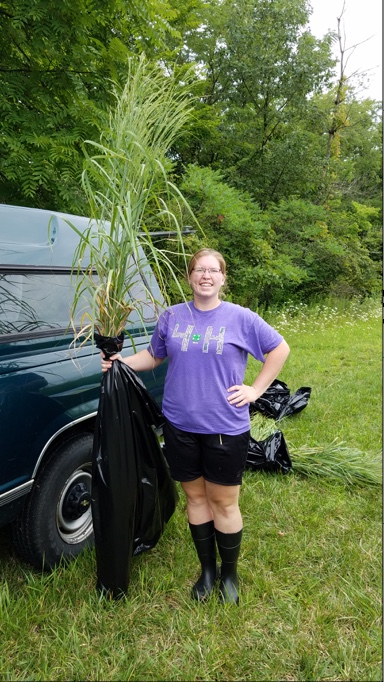Switchgrass (Panicum virgatum L.) is a native perennial warm-season grass that is adapted as many ecotypes across North America. In Indiana, switchgrass was found in the Great Prairie when wildlife and the early settler’s livestock in this region used it as a forage resource. In Indiana today, switchgrass is sometimes used a component of warm-season grass paddocks that complement a cool-season grass/legume pasture system. It is a versatile grass as it is used as a landscaping plant, too. Switchgrass is likely sold today as a potted plant in most Indiana landscaping greenhouses and switchgrass seed can be purchased through forage seed companies.
The versatility of this drought and winter tolerant grass has more recently been exploited as a future biofuel resource for the production of energy for people. While the incentive for entrepreneurial companies to invest in a high fiber to energy conversion business is not appealing today, it is interesting to reflect on how many corn grain to ethanol facilities dot Indiana today that were not part of the Indiana economy just a couple of decades ago. If fossil fuel prices increase and the world’s fuel economy is unstable, high fiber (cellulosic) feedstocks may have potential in the future.
Research conducted at Purdue University evaluated the growth, development, quality, and yield of two diverse switchgrass varieties that received different rates of nitrogen (N) fertilizer. The varieties used were ‘Shawnee’, an upland variety that has improved digestibility and developed for livestock use, and ‘Liberty’ which is a variety that has both upland and lowland ecotype genetics. This combination of upland and lowland genetics was theorized to have more yield and adequate winterhardiness in the Midwest USA. ‘Liberty’ was the first variety to be released as a biofuel-purpose switchgrass.
Purdue University research results indicated that livestock producers interested in including switchgrass into their pasture rotations should consider ‘Shawnee’ over ‘Liberty’ as ‘Shawnee’ had lower fiber concentration and better digestibility.
It has been noted with past research that the best time to harvest switchgrass as a biofuel feedstock is after a killing freeze has occurred. The objective is to harvest a high yielding, low concentration N and high concentration fiber biofuel feedstock. The last harvest time in the Purdue research was late September.
Nitrogen-fertilized switchgrass in early May still had higher N composition at the last harvest. Switchgrass receiving no N fertilizer yielded as much as switchgrass receiving 60 pounds of N per acre. Switchgrass receiving N fertilizer was often falling down (lodged) before the final harvest, which creates harvest difficulties. ‘Liberty’ had higher fiber than ‘Shawnee’ at the final harvest. The low concentration of N and high concentration of fiber in switchgrass late season is ideal for conversion of switchgrass to biofuel products. ‘Liberty’ was 8.8 percent higher yielding in Indiana, and was standing better at each final harvest as compared to ‘Shawnee’.
Switchgrass is a versatile forage that may become part of the Indiana bio-economy in the future. For more details about switchgrass and its use as a cellulosic fuel feedstock visit the CenUSA Bioenergy website at https://cenusa.iastate.edu/.Switchgrass – Shawnee and Liberty

The photo of ‘Liberty’ and ‘Shawnee’ switchgrass at the Purdue University Crop Diagnostic Training and Research Center illustrates the better yield potential and less lodging of ‘Liberty as compared to ‘Shawnee’ switchgrass. (Photo Credit: Keith Johnson)



